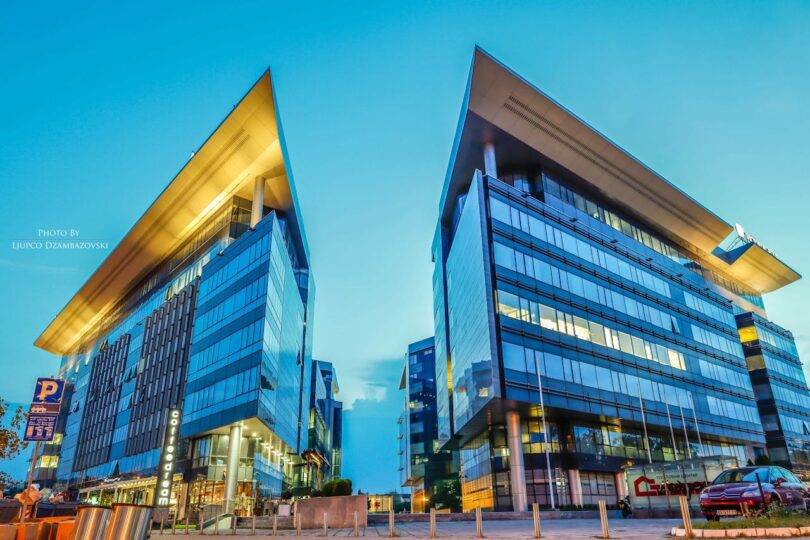A business park is a planned commercial development designed to accommodate multiple businesses in one area. Traditionally, these parks were characterized by low-rise buildings, expansive parking, and suburban locations. However, in the 21st century, business parks have evolved dramatically. No longer just places to work, modern parks are becoming innovation ecosystems that foster collaboration, community, and economic growth.
From Silicon Valley’s high-tech clusters to Sydney’s Norwest Business Park, these spaces are being reimagined to meet the demands of a dynamic and connected workforce.
The Rise of Business Parks: A Historical Overview
The concept of a business park emerged in the 1950s with the creation of the first suburban office park in Mountain Brook, Alabama. It offered convenience for workers to drive, park, and access their offices in one seamless experience.
During the 1970s and 1980s, business parks flourished as companies sought cost-effective and spacious office environments outside congested city centers. They were built on the promise of:
- Easy commute access
- Ample parking
- Cost-effective leases
- Functional office layouts
As the internet and globalization transformed work, these early business parks began to feel outdated. Today, a new wave of vibrant, tech-driven spaces is rising to replace or revitalize traditional parks.
Defining Features of Traditional vs. Modern Business Parks
| Feature | Traditional Business Park | Modern Business Park |
|---|---|---|
| Layout | Isolated, low-rise buildings | Mixed-use, integrated communities |
| Transportation | Car-centric | Emphasis on public transport & walkability |
| Amenities | Minimal | Cafes, gyms, childcare, open spaces |
| Purpose | Functional office space | Innovation, collaboration, and lifestyle |
| Sustainability | Low priority | High priority (LEED certification, green spaces) |
This transformation signals a broader shift in how we work and what employees and companies value.
Key Benefits of a Business Park in Today’s World
Modern business parks provide a range of benefits that appeal to both employers and employees:
1. Strategic Location
Most business parks are strategically located near highways, airports, or rail systems. This accessibility boosts supply chain efficiency and employee convenience.
2. Flexible Space Options
From co-working environments to large office buildings, modern business parks offer scalable space for startups, SMEs, and global corporations.
3. Shared Amenities
Features such as shared conference rooms, cafeterias, recreational zones, and wellness centers improve employee productivity and satisfaction.
4. Networking and Collaboration Opportunities
By bringing diverse companies together, business parks foster networking and cross-sector collaboration, often within high-tech and research-driven industries.
5. Economic Growth Catalyst
They attract investment, boost employment, and stimulate regional economic development, particularly in emerging markets.
Real-World Examples of High-Impact Business Parks
Norwest Business Park – Sydney, Australia
Built in 1983, Norwest spans 172 hectares and houses over 400 companies. It includes open spaces, lakes, a shopping center, and even an ice-skating rink. Today, it’s evolving further with a new train station and medium-density housing.
South Lake Union – Seattle, USA
Anchored by Amazon, South Lake Union has grown into a bustling innovation ecosystem with medical labs, startups, public parks, and modern housing.
Cambridge Science Park – UK
Affiliated with the University of Cambridge, this park connects academia with enterprise, hosting biotechnology firms, R&D labs, and global investors.
Elk Grove Village – Illinois, USA
Home to North America’s largest industrial park, this site supports logistics, manufacturing, and corporate headquarters, offering over 5,600 businesses in one space.
Business Parks vs. Innovation Ecosystems: The New Standard
Modern business parks are increasingly being referred to as innovation ecosystems. These go beyond traditional zoning to create communities where people live, work, and innovate.
Key Differences:
- Integration with Academia: Proximity to universities fuels talent pipelines and research partnerships.
- Diverse Housing Options: Ranging from affordable apartments to luxury condos.
- Cultural Infrastructure: Art galleries, theaters, and public installations contribute to community vibrancy.
- Data & Tech Infrastructure: High-speed internet, IoT connectivity, and smart utilities are standard.
Essential Infrastructure in Modern Business Parks
To thrive, today’s business parks must include:
- Advanced Telecommunications Networks
- Smart Buildings with energy-efficient designs
- Transit-Oriented Development
- Security Systems with integrated monitoring
- Eco-friendly Landscaping
Sustainable features like solar panels, green roofs, and water recycling are no longer optional but expected.
The Role of Anchor Tenants
Anchor tenants (like Amazon in South Lake Union) play a key role in:
- Attracting smaller tenants
- Building brand recognition
- Establishing service and supply chains
- Shaping park culture and architecture
This model benefits both large companies seeking prominence and smaller firms seeking association and support.
The Business Park and the Future of Work
The shift to remote and hybrid work means that business parks must evolve:
- Flexibility First: Parks now feature flexible leases, hot-desking, and modular office spaces.
- Wellness Integration: Mental health rooms, natural lighting, and access to nature boost well-being.
- Collaboration Zones: Open spaces and innovation labs encourage idea sharing.
- Tech-Ready Spaces: Business parks are equipped with fiber optics, 5G, and AR/VR capabilities.
Global Trends Shaping Business Parks
1. Urban Infill and Redevelopment
Urban business parks are replacing older industrial zones and bringing economic revitalization to city cores.
2. Special Economic Zones (SEZs)
In countries like China and India, business parks double as SEZs, offering tax benefits and reduced regulation to attract foreign investment.
3. Green Business Parks
Environmental sustainability is a defining trend, with parks competing to be net-zero or carbon-negative.
4. Co-location and Vertical Integration
Mixing offices, manufacturing, logistics, and R&D in one site fosters rapid innovation and efficiency.
What Businesses Should Look for in a Business Park
When choosing a business park, companies should evaluate:
- Industry Synergy: Presence of related businesses for partnerships
- Cost vs. Value: Lease terms, utility costs, and value-added services
- Long-Term Viability: Plans for growth, infrastructure upgrades, and community support
- Safety and Security: On-site personnel, smart surveillance, and disaster readiness
Business Parks in the Age of Smart Cities
As smart cities rise, business parks are becoming integrated nodes of urban innovation. Features include:
- IoT-enabled Devices: Real-time traffic and energy data
- AI-powered Resource Allocation
- Green Transport Solutions: EV charging stations and bike-share programs
How Governments Support Business Park Development
Public-private partnerships, tax incentives, and grants often drive the creation of business parks. These efforts:
- Promote regional equity
- Generate employment
- Encourage innovation through incubators and accelerators
Conclusion: Business Parks as Engines of Innovation
The traditional business park model is giving way to integrated, tech-enabled ecosystems that support both human connection and technological advancement. As businesses, governments, and communities continue to prioritize sustainability, collaboration, and innovation, the business park of the future is already here—and it’s reshaping the way we work, live, and grow.
Whether you’re a startup or a Fortune 500, the right business park can unlock opportunities and transform your potential into progress.




Leave a Comment